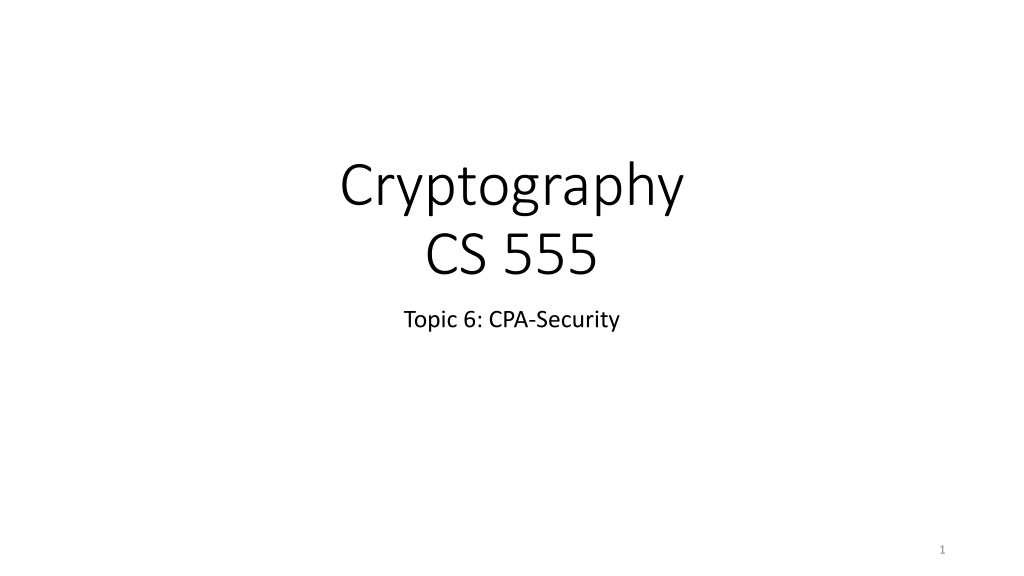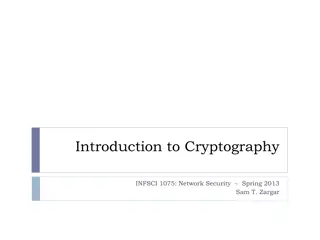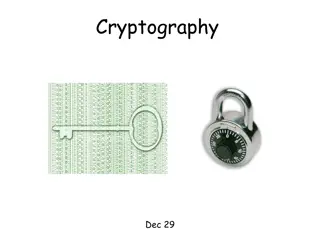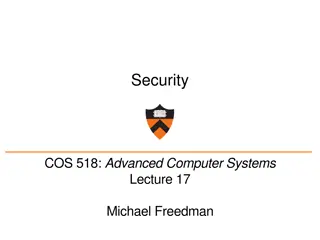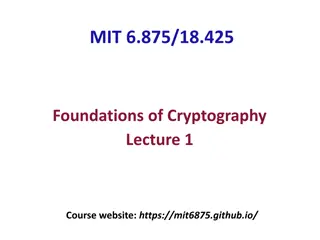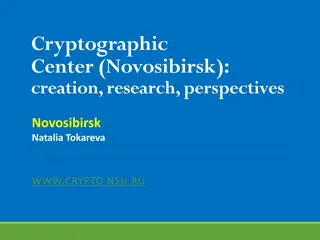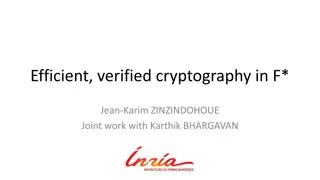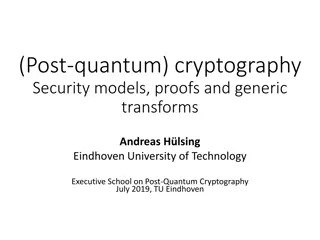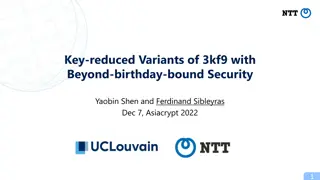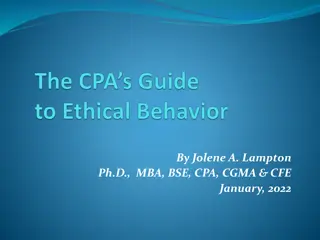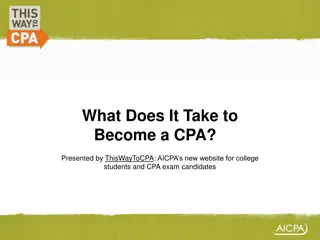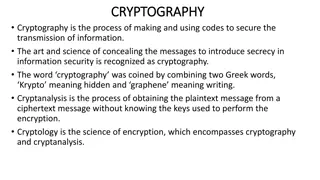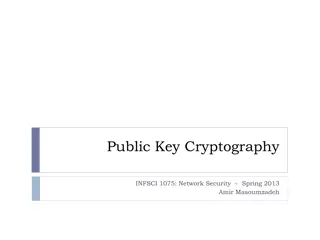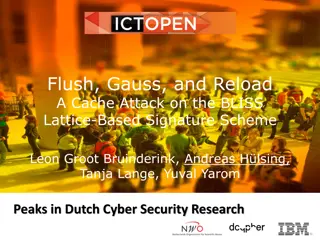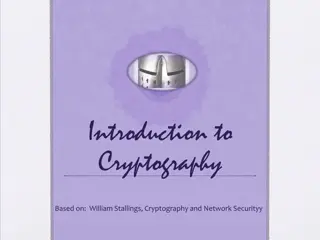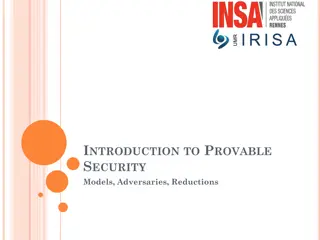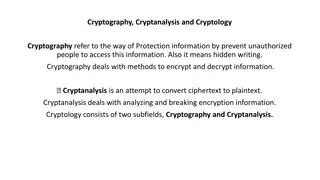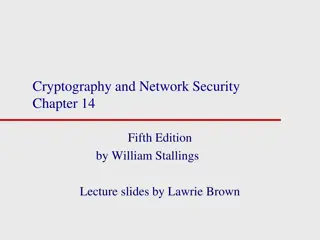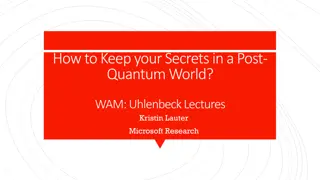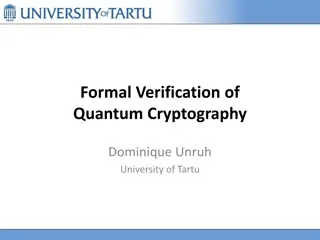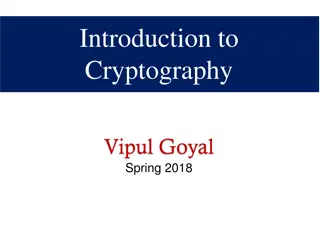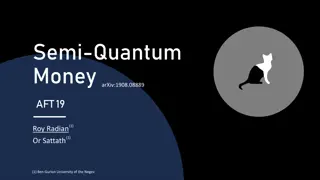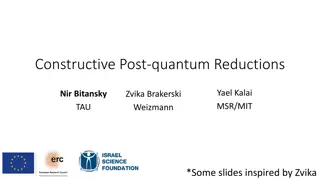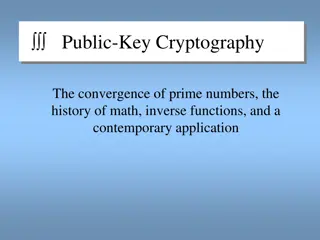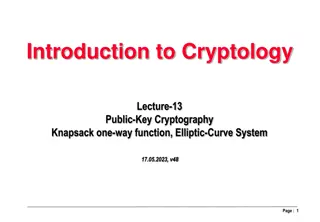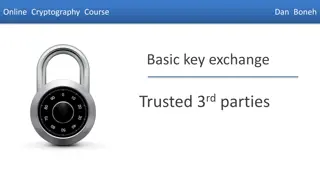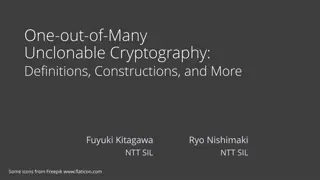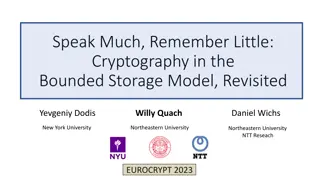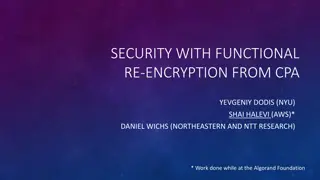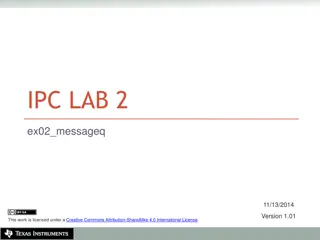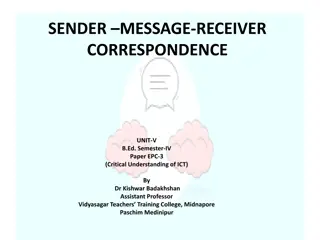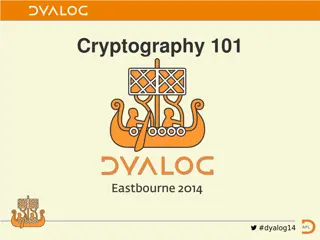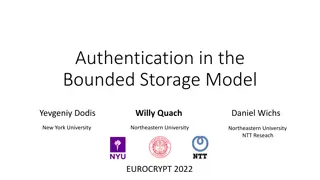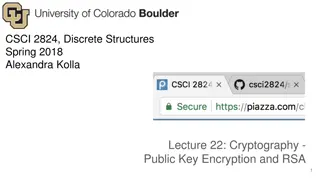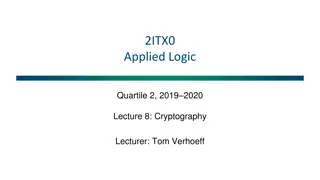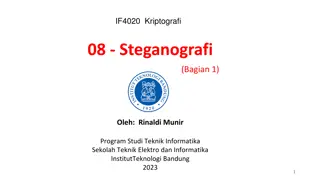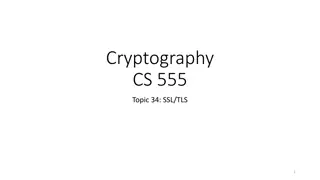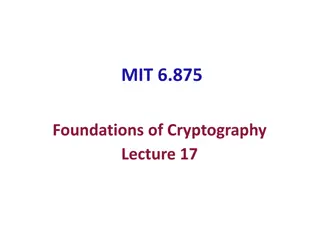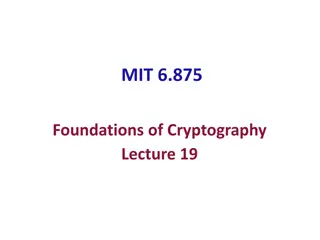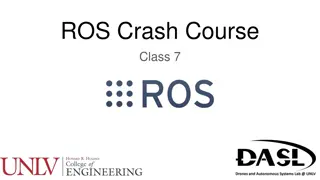CPA-Security and Multiple Message Security in Cryptography
Today's goal is to build a CPA-secure encryption scheme focusing on multiple message security. The concept of indistinguishable multiple encryptions against eavesdropping attackers is explored, highlighting the importance of secure encryption schemes in the presence of an eavesdropper. The experiment demonstrates scenarios, analysis, and observations related to encryption security in cryptographic systems.
Download Presentation

Please find below an Image/Link to download the presentation.
The content on the website is provided AS IS for your information and personal use only. It may not be sold, licensed, or shared on other websites without obtaining consent from the author. Download presentation by click this link. If you encounter any issues during the download, it is possible that the publisher has removed the file from their server.
E N D
Presentation Transcript
Cryptography CS 555 Topic 6: CPA-Security 1
Recap Sematic Security/Indistinguishable Encryptions against eavesdropping attacker with one ciphertext Pseudorandom Number Generators Today s Goal: Multiple Message Security and CPA- Security. Build CPA-secure encryption scheme 3
Multiple Message Eavesdropping Experiment (m0,1, ,m0,t), (m1,1, ,m1,t) Random bit b K = Gen(.) ci = EncK(mb,i) (c1, ,ct) b ??? ???????? ?????????? ???????? ??????? ? = ? 1 Pr 2+ ?(?) 4
Multiple Message Eavesdropping Experiment m0, m1 ????????,??? = ???? ? ? ?????????? ???????????? ?????? ? ?????? ???????? ???,???,??? ?????? ? ? ?????????? ?? ???, Random bit b K = Gen(.) c = EncK(mb) c ????= 1 ?? ? = ? ????= 0 ?? ?????? b ??????, ??????, ?? ???????????? ???? ???????? ??????????? ?? ? ? ???????? ?? ?? ???????????? ?? ??? ??? ??? ????????? ?,? ??? ?? ? Negligible function ? such that Pr[??????, ??? ???????? ?????????? ???????? ????= 1] 1 2+ ?(?) ??????? ? = ? 1 Pr 2+ ?(?) 5
A Simple Observation If has indistinguishable multiple encryptions in the presence of an eavesdropper then also has indistinguishable encryptions in the presence of an eavesdropper. In fact indistinguishable multiple encryptions is a strictly stronger security notion. 6
Example Encs(m) = G(s) ? Decs(c) = G(s) ? Recall: = presence of an eavesdropper. ???,???,??? has indistinguishable encryptions in the Claim: = encryptions in the presence of an eavesdropper. ???,???,??? does not have indistinguishable multiple 7
Multiple Message Eavesdropping (0 (?), 0 (?)), (0 (?), 1 (?)) Random bit b s = Gen(.) ci = EncK(mb,i) (G(s) mb,1, G(s) mb,2) b b = 1 if c1=c2 0 otherwise Analysis: If b=1 then c1= G(s) 0 (?) =c2 Analysis: If b=0 then c1= G(s) 0 (?) G(s) 1 (?) =c2 8
Did We Cheat? Attack specifically exploited the fact that we can ask to see multiple encryptions of the same message The above argument might appear to show that no encryption scheme provides secure indistinguishable multiple encryptions in the presence of an eavesdropper. Theorem: If is (stateless) encryption scheme and Enc is deterministic then does not provide secure indistinguishable multiple encryptions 9
Did We Cheat? Option 1: Weaken the security definition so that attacker cannot request two encryptions of the same message. Undesirable! Example: Dataset in which many people have the last name Smith We will actually want to strengthen the definition later Option 2: Consider randomized encryption algorithms 10
Chosen-Plaintext Attacks Model ability of adversary to control or influence what the honest parties encrypt. During World War 2 the British placed mines at specific locations, knowing that the Germans, upon finding the mines, would encrypt the location and send them back to headquarters. The encrypted messages helped cryptanalysts at Bletchley Park to break the German encryption scheme. 11
Chosen-Plaintext Attacks Model ability of adversary to control or influence what the honest parties encrypt. Battle of Midway (WWII). US Navy cryptanalysts intercept and encrypted message which they are able to partially decode (May 1942). The message stated that the Japanese were planning an attack on AF? Cryptanalysts could not decode ciphertext fragment AF. Best Guess: AF = Midway Island. 12
Battle of Midway (WWII). US Navy cryptanalysts intercept and encrypted message which they are able to partially decode (May 1942). Message stated that the Japanese were planning a surpise attack on AF Cryptanalysts could not decode ciphertext fragment AF. Best Guess: AF = Midway Island. Washington believed Midway couldn t possibly be the target. Cryptanalysts then told forces at Midway to send a fake message freshwater supplies low The Japanese intercepted and transmitted an encrypted message stating that AF is low on water. 13
Battle of Midway (WWII). US Navy cryptanalysts intercept and encrypted message which they are able to partially decode (May 1942). Message stated that the Japanese were planning a surpise attack on AF Cryptanalysts could not decode ciphertext fragment AF. Best Guess: AF = Midway Island. Washington believed Midway couldn t possibly be the target. Cryptanalysts then told forces at Midway to send a fake message freshwater supplies low The Japanese intercepted and transmitted an encrypted message stating that AF is low on water. 14
Multiple Message Security and CPA-Attacks Multiple Message Security Attacker must select all messages at the same time. Significant Limitation! In the WWII attacks cryptanalysts selected the message adaptively Selected message(s) to encrypt after observing target ciphertext 15
CPA-Security (Single Message) m0,m1 c = EncK(mb) m2 c2 = EncK(m2) m3 c3 = EncK(m3) b Random bit b K = Gen(.) ??? ? ? (negligible) s.t Pr ? ??????? ? = ? 1 2+ ?(?) 16
CPA-Security (Single Message) m0,m1 c = EncK(mb) ????????,??? = ???? ? ? ?????????? ??????????? ?????? ? ?????? ???????? ???,???,??? ?????? ? ? ?????????? ?? ???, m2 c2 = EncK(m2) = 1 ?? ? = ? = 0 ?? ?????? m3 ??? ??????, ??????, c3 = EncK(m3) ??? b ?? ???????????? ???? ??????????? ????? ? ? ???? ????????? ?????? ?? ??? ??? ??? ??????????? ?,? ??? ?? ? negligible function ? such that Pr[??????, Random bit b K = Gen(.) = 1] 1 ??? 2+ ?(?) ??? ? ? (negligible) s.t Pr ? ??????? ? = ? 1 2+ ?(?) 17
CPA-Security (Multiple Messages) m0,1,m1,1 c1 = EncK(mb,1) m0,2,m1,2 c2 = EncK(mb,2) m0,3,m1,3 c3 = EncK(mb,3) b Random bit b K = Gen(.) ??? ? ? (negligible) s.t Pr ? ??????? ? = ? 1 2+ ?(?) 18
CPA-Security Theorem: An encryption scheme = for single encryptions is also CPA-secure for multiple encryptions. ???,???,??? that is CPA-Secure We will simply say CPA-security for simplicity To show CPA-Security it suffices to show CPA-security for single encryptions. To reason about security of a protocol using we can use game with multiple encryptions. 19
CPA-Security CPA-security vs Multiple Message Encryption CPA-security is stronger guarantee Attacker can select messages adaptively CPA-security minimal security notion for a modern cryptosystem Limitations of CPA-Security: Does not model and adversary who Attempts to modify messages Can get honest party to (partially) decrypt some messages 20
CPA-Security and Message Length Observation: Given a CPA-secure encryption scheme = ???,???,??? that supports messages of a single bit ( = 0,1 ) it is easy to build a CPA-secure scheme = supports messages m = m1, ,mn 0,1? of length n. ??? ,??? ,??? that ? = Enck ?1, ,Enck ?? Enck Exercise: How would you prove is CPA-secure? 21
Security Reduction Step 1: Assume for contraction that we have a PPT attacker A that breaks CPA-Security. Step 2: Construct a PPT distinguisher D which breaks PRF security. 22
Next Class Read Katz and Lindell 3.5-3.6.1 Constructing CPA-Security with Pseudorandom Functions 23
